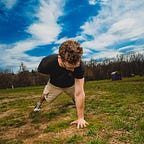How to Do More Pullups The (Almost) Easy Way
There’s a famous old weightlifter’s saying that goes a little something like this:
“To press a lot, you must press a lot”
Meaning “(in order to) press a lot (of weight), you must press a lot (often/for a lot of reps)”.
The same holds true for just about any exercise, but particularly for upper body exercises.
While you can often succeed on a more modest volume at things like squats or deadlifts (if you do them), the same does not hold true for the upper body exercises that make you wanna whip your shirt off in front of innocent passers-by, strike a double biceps pose, and go “hey, do you have the number for a veterinarian? ‘CUZ THESE PUPPIES ARE SICK!” (the biceps being the “puppies”, of course).
One such exercise is, naturally, the pullup — hands down (or up, I guess) the best upper body strength and muscle developer around. I just can’t get enough of ’em, and whether or not you know it yet, neither can you. Seriously.
Pullups not only work wonders for making you look good, they also strengthen a heaping pile of muscles, including:
· Lats
· Midback
· Biceps (i.e. “puppies”)
· Grip
· Forearms
· Abs
· Rear deltoids (back of your shoulders)
Plus, they’re fun. Can’t forget about that.
The problem?
Most people approach pullups the “gym bro” way — all out for 2–3 sets, followed by collapsing in a heap. And I’ll make the observation that most of these people have the absolute worst looking form on pullups and generally aren’t impressively strong at them either.
But if you need to do a lot of pullups to get good at pullups, but doing a lot of pullups wears you out…how are you supposed to get stronger at pullups?
The exercise equivalent of the Zen Koan “What is the sound of one hand clapping”?
Not quite.
Enter the ladder.
Ladders are an age-old technique used to increase strength endurance and build muscle, but according to Russian strength expert Anatoliy Bondarchuk, “the cumulative effect of a large amount of many low-intensity sets has a somewhat similar effect to that of a heavy load” — and that’s where ladders come in.
A ladder is where you choose an exercise and do 1 rep, rest briefly, 2 reps, rest briefly, and keep going until you’ve reached your desired number of reps. After you reach your top set, you start back over at one.
In his landmark book Beyond Bodybuilding, Pavel Tsatsouline tells about his time serving in the Russian Special Forces and being required to knock out 18 strict pullups with 10 kgs strapped to you as one of your PT tests — or else. He and his classmates would head out to the pullup bars between classes and simply do ladders in pairs until one could not continue. Their mini workouts would look something like this:
1, 2, 3, 4, 5, 6, 7, rest. 1, 2, 3, 4, 5, rest. — etc.
When the time came to do their 18 reps with 10 kgs extra, he and his other diligent classmates could do so with great ease. It should come as no surprise, then, that he could also later do pullups with just one arm (with some specialized practice, of course).
The moral of the story: volume (i.e. number of reps performed) matters — more than intensity (i.e. heaviness), as a matter of fact. Volume is what lays the foundation upon which you can build your higher-level strength — and “sneaking up” on your strength with ladders is a perfect way to get bigger, stronger, leaner, and more powerful without killing yourself in the process.
Give this a shot from now on when you do your pullups and drop me a line in a few weeks and let me know how it goes for you. Betcha get a lot stronger and can do a lot more. You’ll probably also need a new set of shirts, as well.
On that note, if you like training that:
- Gives you more strength than it takes from you
- Improves your stamina and resilience simultaneously
- Powers-up every nook, cranny, crevice, and corner of your Soft Machine
Then you just might like my 9-Minute Kettlebell and Bodyweight Challenge.
As the name indicates, it’s just 9 minutes long, and it’s designed to be done WITH your current workouts — NOT instead of them.
Even cooler:
Many find that it actually amplifies their strength in their favorite kettlebell and bodyweight moves, like presses, squats, pullups, and more.
And best of all, it’s free.
How free?
I’m talkin’ freer than the 4th of July, my friend.
Get thee thine own copy here => http://www.9MinuteChallenge.com
Have fun and happy training!
Aleks Salkin
